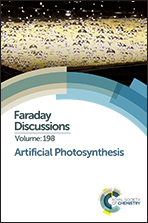Photocatalytic H2 production using a hybrid assembly of an [FeFe]-hydrogenase model and CdSe quantum dot linked through a thiolato-functionalized cyclodextrin†
Abstract
It is a great challenge to develop iron-based highly-efficient and durable catalytic systems for the hydrogen evolution reaction (HER) by understanding and learning from [FeFe]-hydrogenases. Here we report photocatalytic H2 production by a hybrid assembly of a sulfonate-functionalized [FeFe]-hydrogenase mimic (1) and CdSe quantum dot (QD), which is denoted as 1/β-CD-6-S–CdSe (β-CD-6-SH = 6-mercapto-β-cyclodextrin). In this assembly, thiolato-functionalized β-CD acts not only as a stabilizing reagent of CdSe QDs but also as a host compound for the diiron catalyst, so as to confine CdSe QDs to the space near the site of diiron catalyst. In addition, another two reference systems comprising MAA–CdSe QDs (HMAA = mercaptoacetic acid) and 1 in the presence and absence of β-CD, denoted as 1/β-CD/MAA–CdSe and 1/MAA–CdSe, were studied for photocatalytic H2 evolution. The influences of β-CD and the stabilizing reagent β-CD-6-S− on the stability of diiron catalyst, the fluorescence lifetime of CdSe QDs, the apparent electron transfer rate, and the photocatalytic H2-evolving efficiency were explored by comparative studies of the three hybrid systems. The 1/β-CD-6-S–CdSe system displayed a faster apparent rate for electron transfer from CdSe QDs to the diiron catalyst compared to that observed for MAA–CdSe-based systems. The total TON for visible-light driven H2 evolution by the 1/β-CD-6-S–CdSe QDs in water at pH 4.5 is about 2370, corresponding to a TOF of 150 h−1 in the initial 10 h of illumination, which is 2.7- and 6.6-fold more than the amount of H2 produced from the reference systems 1/β-CD/MAA–CdSe and 1/MAA–CdSe. Additionally, 1/β-CD-6-S–CdSe gave 2.4–5.1 fold enhancement in the apparent quantum yield and significantly improved the stability of the system for photocatalytic H2 evolution.
- This article is part of the themed collection: Artificial Photosynthesis


 Please wait while we load your content...
Please wait while we load your content...